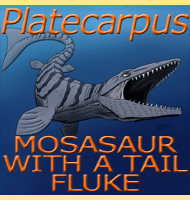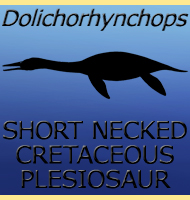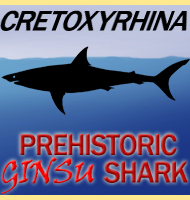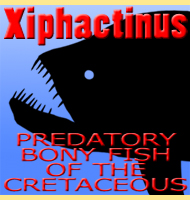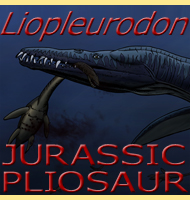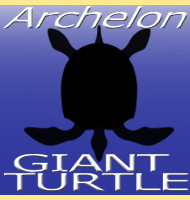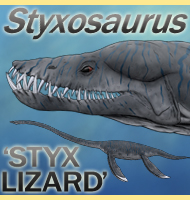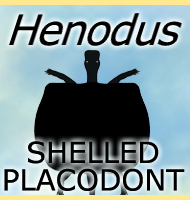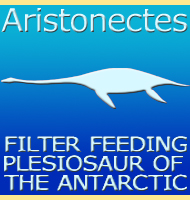


Plotosaurus
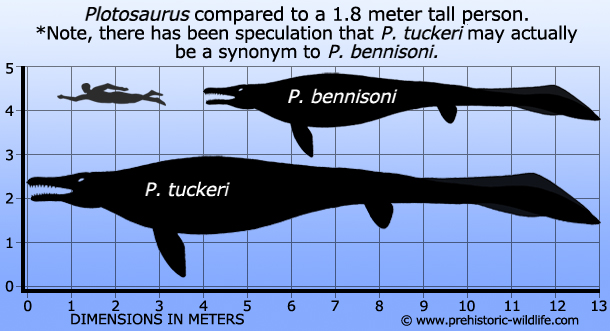
Name:
Plotosaurus
(Swimmer lizard).
Phonetic: Plo-toe-sore-us.
Named By: Charles Lewis Camp - 1951
(originally described in 1942, but under the name Kolposaurus).
Synonyms: Garzasaurus. Possibly
Plotosaurus tuckeri.
Classification: Chordata, Reptilia, Squamata,
Mosasauridae, Mosasaurinae.
Species: P. bennisoni
(type), P. tuckeri?
Diet: Carnivore/Piscivore.
Size: Body around 9 meters long with a 39
centimetre skull for P. bennisoni, and a body
up to 13 meters long with a 59 centimetre skull for P.
tuckeri.
Known locations: USA - California - Moreno
Formation.
Time period: Maastrichtian of the Cretaceous.
Fossil representation: Remains of at least a few
individuals as well as skin impressions.
In
1937 a fossil collector named Allan Bennison discovered mosasaur
fossils in California’s Mount Diablo Range. These fossils were first
described by Charles Camp in 1942 and published as Kolposaurus;
however this name is actually preoccupied as a synonym for
Nothosaurus,
hence the naming revision to Plotosaurus in 1951.
The
original fossils were of more than one individual, with one being
quite a bit larger than the other. Whereas the type species P.
bennisoni reached nine meters, the second species , P.
tuckeri
reached thirteen meters long, just a bit short of giants such as
Tylosaurus
and Mosasaurus,
though possibly equal to Hainosaurus.
However the future of P. tuckeri is in doubt since a 2008 review
by Lindgren, Caldwell and Jagt concluded that P. tuckeri
should
actually be treated as a synonym to the type species P.
bennisoni.
Plotosaurus
represents a mosasaur
that is significantly better adapted to swimming
than most of its known relatives. The body is more streamlined with a
fairly rigid forward body that would have stabilised the swimming
pattern of Plotosaurus reducing turbulence and
subsequent drag. Skin
impressions for Plotosaurus have also revealed
specially adapted scales
that have been interpreted as being analogous to those of sharks in
that they were capable of producing vortices as they moved through the
water to reduce drag even further.
The
limbs shaped into flippers were also streamlined to help reduce drag
through the water, and in addition to this the skull of Plotosaurus
was very long but also slender. Other interesting features of the
skull are the openings for large eyes, and when you combine these
with the rigidity of the forward body, you get a marine reptile that
is possibly analogous to the opthalmosaurid ichthyosaurs
that lived
earlier. These fast swimming and deep diving ichthyosaurs do not seem
to be present at the end of the Cretaceous, so this quite a
tantalising idea that mosasaurs like Plotosaurus
were developing to
fill an ecological void left by them. Another feature of Plotosaurus
are the large nasal openings that facilitated a faster transfer of
fresh air into the lungs. This could be either to cope with a faster
and hence more energetic style of swimming, or deep diving trips
beneath the surface where Plotosaurus would have to
of held its breath
but replace the oxygen depleted air in its lungs quickly when back on
the surface.
Plotosaurus
was not the only mosasaur named by Charles Camp in 1942 (even if it
was as Kolposaurus), another genus from the
Moreno Formation called
Plesiotylosaurus
was also named by him. Other marine reptiles from
the Moreno Formation include the plesiosaurs
Fresnosaurus,
Hydrotherosaurus,
Morenosaurus
and Aphrosaurus.
One candidate for
a possible close relative of Plotosaurus is Eremiasaurus.
Further reading
- Plotosaurus, a new generic name for Kolposaurus
Camp, preoccupied. -
Journal of Paleontology 25:822 - Charles L. Camp - 1951.
- A fishy mosasaur: the axial skeleton of Plotosaurus
(Reptilia,
Squamata) reassessed. - Lethaia 40:153-160. - J. Lindgren, J. W. M.
Jagt & M. W. Caldwell - 2007.
- New data on the postcranial anatomy of the California mosasaur
Plotosaurus bennisoni (Camp, 1942) (Upper
Cretaceous: Maastrichtian),
and the taxonomic status of P. tuckeri (Camp,
1942). - Journal of
Vertebrate Paleontology 28(4):1043-1054. - J. Lindgren, J. W. M. Jagt
& M. W. Caldwell - 2008.
- Skin of the Cretaceous mosasaur Plotosaurus:
implications for aquatic
adaptations in giant marine reptiles - Biology Letters - J. Lindgren,
C. Awlmark, M. W. Caldwell & A. R. Fiorillo - 2009.
----------------------------------------------------------------------------
Random favourites
 |
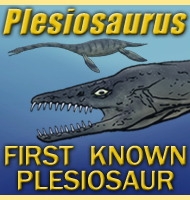 |
 |
